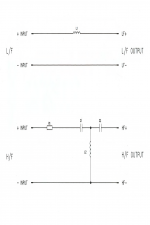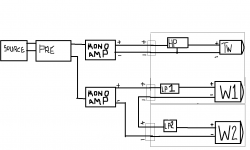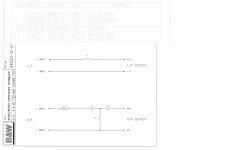I have a conundrum. after years of living in an apartment with a growing Hi-Fi and a limit on volume I have finally got myself a detached house to let my Hi-Fi sing. since my amp upgrades grew to increase sound quality my speakers never grew to accommodate volume due to apartment life. it didn't take long before I blew my humble B&W DM601s2's. The woofer has gone in one channel. looking around on line I found a few options to replace the woofer, I left some bids on and I got a new replacement driver. I forgot about the other bids and I now have another pair of DM601 S2 speakers (minus the tweeters). my thinking is....can I hook up the second set of speakers in parallel with the first set? are there any merits to this? will this reduce the load on each individual woofer? will I get a better sound quality? or will i have half the volume in the woofers with the same sound quality, while the hi freq has a normal load? I could amplify each driver, 50w to hi, 100w to mid1, 100w to mid2. Would a diy xover let me take better advantage of this situation? or should I just keep the volume low and save up and buy a proper set of screamers? Ultimately i Know i need new speakers, this will happen but the engineer in me wants to see if i can put the collection of speaker parts i now have to better use before i buy new ones.
current xover cut off is 4k, speaker range is 60-20k.
I now have:
x2 DM601 S2 (full working order, cabinet, xover, all drivers)
x2 DM601 S2 (tweeters removed, only cabinet, xover + woofers)
x1 pre amp (musical fidelity xp100)
x2 dual mono power amps, effectively 4 amps (musical fidelity xas100, 100w p/c each)
x2 power amps (musical fidelity xa50 mono amps, 50w p/c each)- not in use but optional
I am no stranger to a soldering iron and hoped a custom solution is available.
what to do? all comments/advice/suggestions welcome.
current xover cut off is 4k, speaker range is 60-20k.
I now have:
x2 DM601 S2 (full working order, cabinet, xover, all drivers)
x2 DM601 S2 (tweeters removed, only cabinet, xover + woofers)
x1 pre amp (musical fidelity xp100)
x2 dual mono power amps, effectively 4 amps (musical fidelity xas100, 100w p/c each)
x2 power amps (musical fidelity xa50 mono amps, 50w p/c each)- not in use but optional
I am no stranger to a soldering iron and hoped a custom solution is available.
what to do? all comments/advice/suggestions welcome.
Last edited:
You buy new tweeters or
You use the midwoofers you have available.
2nd Pair:
Take out the midwoofers.
Trash or sell the enclosure and crossovers.
Make a new enclosure about double or triple the (B&W DM601 S2) previous volume (net).
Use them as 2 subwoofers.
Go to a 6 db Crossover Table and match impedance so you can pick up a new coil@200/300Hz.
Buy new coils with very low DCR for your new subwoofers.
Connect them to the available amp (?) "x2 power amps (musical fidelity xa50 mono amps)- not in use but optional".
You presented yourself with a new pair of B&W subs. 😀
Bowers & Wilkins DB1 subwoofer | Stereophile.com
http://www.diyaudio.com/forums/subwoofers/240223-b-w-acoustitune.html
http://www.bwgroupsupport.com/downloads/manuals/bw/Acoustitune Brochure.pdf
You use the midwoofers you have available.
2nd Pair:
Take out the midwoofers.
Trash or sell the enclosure and crossovers.
Make a new enclosure about double or triple the (B&W DM601 S2) previous volume (net).
Use them as 2 subwoofers.
Go to a 6 db Crossover Table and match impedance so you can pick up a new coil@200/300Hz.
Buy new coils with very low DCR for your new subwoofers.
Connect them to the available amp (?) "x2 power amps (musical fidelity xa50 mono amps)- not in use but optional".
You presented yourself with a new pair of B&W subs. 😀
Bowers & Wilkins DB1 subwoofer | Stereophile.com
http://www.diyaudio.com/forums/subwoofers/240223-b-w-acoustitune.html
http://www.bwgroupsupport.com/downloads/manuals/bw/Acoustitune Brochure.pdf
You buy new tweeters or
You use the midwoofers you have available.
2nd Pair:
Take out the midwoofers.
Trash or sell the enclosure and crossovers.
Make a new enclosure about double or triple the (B&W DM601 S2) previous volume (net).
Use them as 2 subwoofers.
Go to a 6 db Crossover Table and match impedance so you can pick up a new coil@200/300Hz.
Buy new coils with very low DCR for your new subwoofers.
Connect them to the available amp (?) "x2 power amps (musical fidelity xa50 mono amps)- not in use but optional".
You presented yourself with a new pair of B&W subs. 😀
Bowers & Wilkins DB1 subwoofer | Stereophile.com
http://www.diyaudio.com/forums/subwoofers/240223-b-w-acoustitune.html
http://www.bwgroupsupport.com/downloads/manuals/bw/Acoustitune Brochure.pdf
Inductor, thanks for the response. I like it a lot.
some questions (sorry!):
the speaker is rated at 8ohms, does this mean the driver, without the tweeter, is rated lower? or calculate at 8ohm.
do i simply add a 4.7mh coil (260hz) to the positive supply to the woofer? to create a 260hz cut off?
what voltage should this be rated to?
is 0.26 DCR acceptable?
the cabinet you mentioned for the subs, would this be an enclosed design?
would i be better using the xa50 (50w) for the tweeters, one of the power amps (100w) for the mid and the second power amp (100w) for the subs?
thanks,
Kevin.
Hi,
I don't see the point of the added "subwoofers" if the
original speakers are well balanced, you'll just screw up.
I can't make any sense of Inductors advice, it is very wrong.
rgds, sreten.
I don't see the point of the added "subwoofers" if the
original speakers are well balanced, you'll just screw up.
I can't make any sense of Inductors advice, it is very wrong.
rgds, sreten.
The possibility that comes to mind with me is connecting two woofers in-series, per channel. The sensitivity of two woofers in-series is the same as that of a single woofer, so relative sensitivity of the woofer and tweeter wouldn't be altered. The two woofers in-series would make it less likely that you will blow a woofer again, as voltage is equally divided between them.
If the existing low-pass filters of the crossover networks are conventional 2nd order, you would make a new low-pass filter (adjusting for the doubling of impedance) by connecting the 2 existing inductors and capacitors of the low-pass filters for the woofer in-series.
Regards,
cT
If the existing low-pass filters of the crossover networks are conventional 2nd order, you would make a new low-pass filter (adjusting for the doubling of impedance) by connecting the 2 existing inductors and capacitors of the low-pass filters for the woofer in-series.
Regards,
cT
It's a first order 0.95mH inductor. If using the two woofers in series, as above post, you need to double the coil to a 1.90 mH (meaning that you can also use the second coil from the extra speaker in series, instead of buying new).
6 db Crossover Table
6 db Crossover Table
If the existing low-pass filters of the crossover networks are conventional 2nd order, you would make a new low-pass filter (adjusting for the doubling of impedance) by connecting the 2 existing inductors and capacitors of the low-pass filters for the woofer in-series.
Regards,
cT
The possibility that comes to mind with me is connecting two woofers in-series, per channel. The sensitivity of two woofers in-series is the same as that of a single woofer, so relative sensitivity of the woofer and tweeter wouldn't be altered. The two woofers in-series would make it less likely that you will blow a woofer again, as voltage is equally divided between them.
If the existing low-pass filters of the crossover networks are conventional 2nd order, you would make a new low-pass filter (adjusting for the doubling of impedance) by connecting the 2 existing inductors and capacitors of the low-pass filters for the woofer in-series.
Regards,
cT
Hi CT, thanks for the suggestion.
This is what I had in mind but do not have the experience to know how it would act or how to implement.
my thinking is two woofers move more air than 1, there must be a way to implement them together, i have no shortage of amplification. The drivers are identical and the cabinets they are currently housed in were designed for these drivers. distancing and phase is something i was unsure about, but this can be tested in practice with listening and then modifications.
i have (hopefully) attached a picture of the B&W xover circuit. It appears to be a 1st order circuit for the low frequency (x1 1.4mh) and 2nd order on the hi frequency (nonsense?). How should i go about implementing the second woofer connected in series. I have attached a picture of how i interpreted your post, am i on the right track? all i am looking for now is a suitable circuit for the in series additional driver.
many thanks,


You have a TV in the room ?
Maybe can stick DM601 woofers in a new enclosure (smaller) and used as back channel, making a 4.0 .... good for movies even music !
Maybe can stick DM601 woofers in a new enclosure (smaller) and used as back channel, making a 4.0 .... good for movies even music !
Last edited:
You have a TV in the room ?
Maybe can stick DM601 woofers in a new enclosure (smaller) and used as back channel, making a 4.0 .... good for movies even music !
hi lexer, thanks for the suggestion. Its a good idea, i had considered this but my AV room does not allow for a speaker behind the sofa. I am really interested in finding a way to to add the extra woofers to my 2 channel hi-fi setup in a feasible way.
cheers
It's a first order 0.95mH inductor. If using the two woofers in series, as above post, you need to double the coil to a 1.90 mH (meaning that you can also use the second coil from the extra speaker in series, instead of buying new).
6 db Crossover Table
Hi Inductor,
Just spotted your post after i replied to CT, this answers most of my questions. So using the existing 1st order LF xover is fine, and using it in series will double the inductance to suit the effect of the driver in series?
If the wiring shown in the previous attachment is correct I will wire these up in the existing enclosures and see how it sounds (still to arrive).
to be clear,
the load will be the same on the amp? I will be driving both of these from a single mono amp.
driver life should be extended as less power is going to each individual driver.
As the sensitivity is the same the amplitude will be the same and not conflict with the tweeter volume balance.
wiring in series will not cause the second driver to be out of phase?
negatives:?:
coherency in image?
positioning?
phase issues?
thanks again.
No, you are deadly wrong. It would be right if talking about 2-Ways but it doesn't work like that for subwoofers. That's why a good enclosure for a sub is not the same for a 2/3-Way with a different alignment (sorry) if you are using the same driver. 😀The drivers are identical and the cabinets they are currently housed in were designed for these drivers.
My first (and only) option (post#2) was that you could regulate output level in your second diy new speaker from the second amp to desired levels (also position in the room). With a higher inductor attached to the drivers (sub) you would also attenuate higher frequencies, with also less probable phase problems (200-2KHz) and image/source conflicts. ""I'm out...!""
No, you are deadly wrong. It would be right if talking about 2-Ways but it doesn't work like that for subwoofers. That's why a good enclosure for a sub is not the same for a 2/3-Way with a different alignment (sorry) if you are using the same driver. 😀
Hi Inductor,
okay I see what your saying, you are suggesting I house them in a larger enclosure as subs only. getting the two suggestions crossed (you and CT). I intend to try them as a second pair using same drivers (2 way enclosure minus the HF) wired in series to working DM601 to proved a second set of mid woofers in their original enclosure.😀
later i may try them as a subs as you have suggested.
Thanks
My first (and only) option (post#2) was that you could regulate output level in your second diy new speaker from the second amp to desired levels (also position in the room). With a higher inductor attached to the drivers (sub) you would also attenuate higher frequencies, with also less probable phase problems (200-2KHz) and image/source conflicts. ""I'm out...!""
Hi Inductor,
I only have 1 pre amp, all my spare amps are power amps. unless i interpret your post wrong i would not be able to regulate the levels to individual speakers.
thanks,
Then forget. I thought about integrates.Hi Inductor,
I only have 1 pre amp, all my spare amps are power amps. unless i interpret your post wrong i would not be able to regulate the levels to individual speakers.
thanks,
The money you get from parts you buy new subs.
Just one thing, you say the inductor is a 1.4 (post#7), so different from the spec-ed 0.95. Maybe a different model (or recent model/year B&W DM601 S2)?!
They are not the same and the driver or/and crossover might have small detailed differences (not the concept overall) of course.
Last edited:
Then forget. I thought about integrates.
The money you get from parts you buy new subs.
Just one thing, you say the inductor is a 1.4 (post#7), so different from the spec-ed 0.95. Maybe a different model (or recent model/year B&W DM601 S2)?!
They are not the same and the driver or/and crossover might have small detailed differences (not the concept overall) of course.
Hi Inductor,
I agree, i'd rather spend time making enclosures and a solution for subs using dedicated sub drivers. I am looking for a quick use with the existing enclosures, if the idea is possible i would consider building an enclosure for the three drivers per speaker if it works out sounding decent.
B&W's DM601 S2 general assembly manual lists the LF inductor as 1.4mH, as far as i am aware the S2 has only one version.
View attachment DM601-TM.pdf
Hi CT, thanks for the suggestion.
This is what I had in mind but do not have the experience to know how it would act or how to implement.
my thinking is two woofers move more air than 1, there must be a way to implement them together, i have no shortage of amplification. The drivers are identical and the cabinets they are currently housed in were designed for these drivers. distancing and phase is something i was unsure about, but this can be tested in practice with listening and then modifications.
i have (hopefully) attached a picture of the B&W xover circuit. It appears to be a 1st order circuit for the low frequency (x1 1.4mh) and 2nd order on the hi frequency (nonsense?). How should i go about implementing the second woofer connected in series. I have attached a picture of how i interpreted your post, am i on the right track? all i am looking for now is a suitable circuit for the in series additional driver.
many thanks,
You're right, that's a first order LP on the woofer, but 3rd order high-pass for the tweeter.
That second schematic of yours is correct. You will have to do some rewiring so that the high-pass filter and tweeter is in parallel circuit with the series connected inductors and woofers to the amplifier speaker terminals.
To try it out, I'd suggest vertically stacking the speaker sys. with the functional tweeter on top of speaker sys. that has a woofer only.
Regards,
cT
For OP,That second schematic of yours is correct. You will have to do some rewiring so that the high-pass filter and tweeter is in parallel circuit with the series connected inductors and woofers to the amplifier speaker terminals.
The Bi-Wiring option on the speakers will help you separate the LP from the HP circuits.
How wait,B&W's DM601 S2 general assembly manual lists the LF inductor as 1.4mH, as far as i am aware the S2 has only one version.
View attachment 409343
I just thought you had read inside the crossover for the inductor component value. What you are saying is that you didn't?! What speakers do you have? You mentioned in the thread the DM601 S2 not the DM601? It doesn't matter, I mean crossover wise (only if you do simulations or buying new components), but what I get is that DM601 S2 uses a 0.95mH inductor on the woofer...
Attachments
For OP,
The Bi-Wiring option on the speakers will help you separate the LP from the HP circuits.
thanks Inductor & cT,
I had wondered about the HF wiring, so by passive bi-amping the HF circuit remains untouched. one amp connects to the hi pass and tweeter, the other to the low pass inductor and in series woofer, inductor, woofer (see attached picture).
is this correct?

- Status
- Not open for further replies.
- Home
- Loudspeakers
- Multi-Way
- Woofer What To Do?
